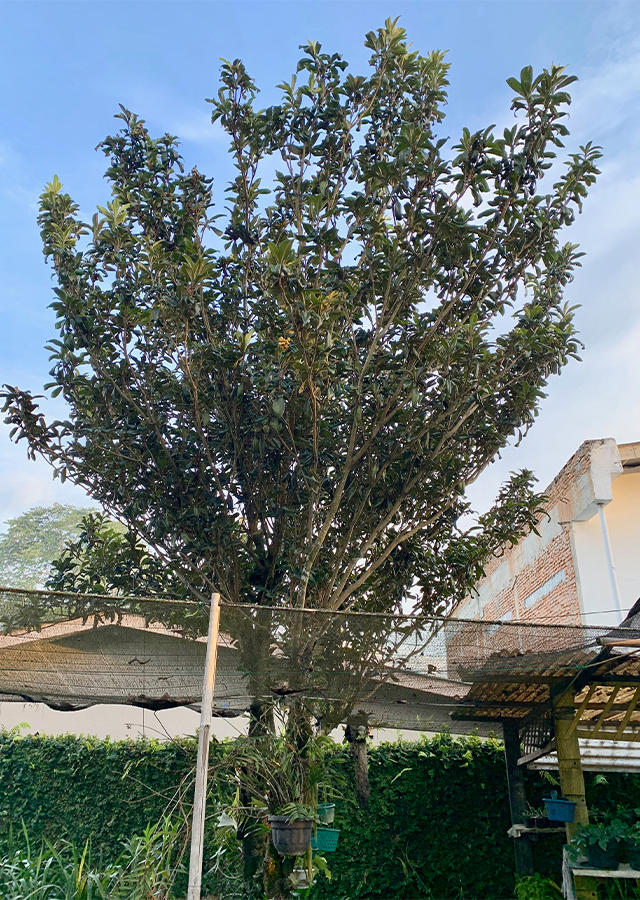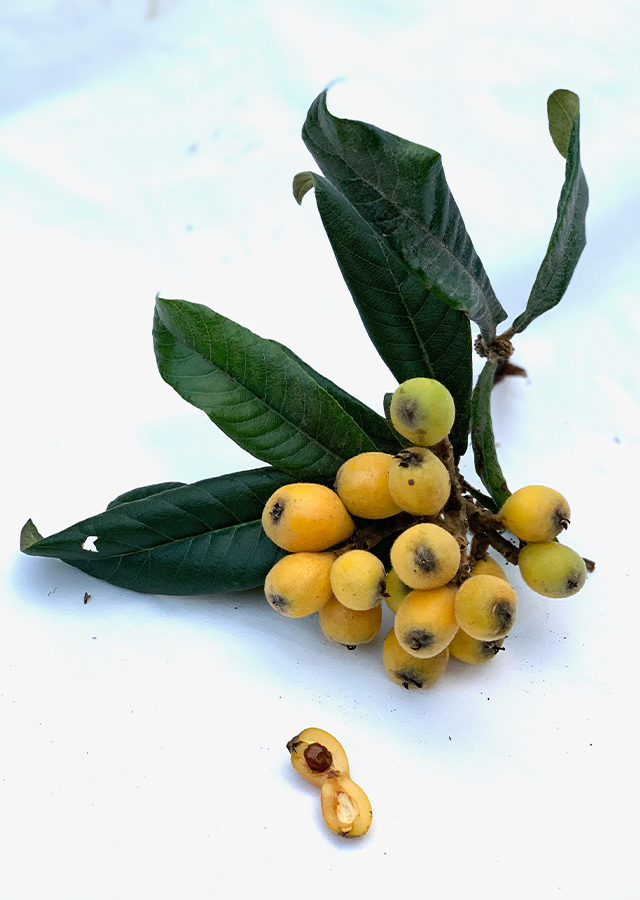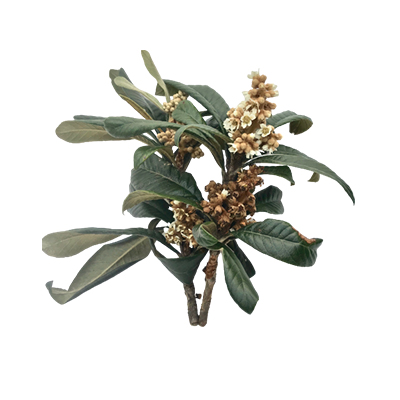Loquat fruit
Rhaphiolepis bibas (Lour.) Galasso & Banfi
Rosaceae
Location in our garden
Orchard



Synonym
Crataegus bibas Lour.
Eriobotrya japonica (Thunb.) Lindl.
Mespilus japonica Thunb.
Habitus
Shrubs. Evergreen, perennial small tree, grows up to 10 m in height
Part Used
Leaves
Seeds
Flowers
Fruit
Growing Requirements
Full Sunshine
Need Shade
Habitat
Forest
Mountains
Overview
Loquat is native to Western China, wild ancestors of the cultivated loquat can still be found in the mountains of Sichuan and Yunnan. It is widely cultivated along the Yangtze River and south-wards, especially in Suzhou. The fragrant flowers of this plant contain essential oils, that can be extracted for use in cosmetics and the seed oil can be used for making soap.
Vernacular Names
Lokhwoot (Thai), Nespola Del Giappone (Italian), Japanse Mispel (Dutch), Lokwat (Indonesia), Tôn leap (Cambodia), and Ti ba diêp (Vietnam)
Agroecology
The loquat is adapted to a subtropical to mild-temperate climate. In China, it grows naturally at altitudes between 900 and 2,000 m. In India, it grows up to 1,500 m and in Guatemala at elevations of 900–1,200 m, yielding poorly at lower elevations. Well-established trees can tolerate a drop in temperature to −11.11 °C.
Morphology
- Stems - a straight low-branched trunk, surmounted by a dense ovoid or globular crown, bark grey, and shallowly fissured.
- Leaves - glossy dark green, margin entire, shallowly serrate apically, coriaceous, large, obovate-oblong or elliptic.
- Flowers - fragrant, ivory- white.
- Fruits - green turning to yellow or orange-yellow, globose or obovate.
- Seeds - brown, angular-ellipsoid, 15 mm by 8 mm.
Cultivation
- By seeds - seeds are sown in the nursery beds after their immediate extraction from fruits. Seeds germinate soon and become seedlings graft able within a year.
- By cuttings - It was used cuttings with and without tip-shoot, with 2 or 4 intact and cut by the half leaves. After 120 days of the plantation, the percentage of survival cuttings were significantly better in the apical cuttings without tip-shoot and with 4 leaves.
Chemical Constituents
Carotenoid, folat, phenolic, chlorogenik, triterpenoid (ursolic acid), tannins, amygdalin, sitrat acid, tartarat acid, suksinat acid, cryptoxanthin, β- carotene, neo-β- carotene, and flavonoids.
Traditional Medicinal Uses
Medicinal Uses
- The fruit is used as a sedative and is thought to reduce vomiting and excessive thirst.
- Antioxidant capacity in leaves and flowers.
- Leaves may possibly relieve diarrhea, support a healthy mood, counteract intoxication, and may also reduce swelling, help combat diabetes, reduction of skin redness.
- The leaves are analgesic, antibacterial, antiemetic, antitussive, antiviral, astringent, diuretic, and expectorant.
- The flowers are expectorant.
Traditional Uses
- The seed oil can be used for making soap.
- A decoction of the leaves or young shoots is used as an intestinal astringent and as a mouthwash in cases of thrush and also in the treatment of bronchitis, coughs, and feverish colds.
Part Used
Reference Sources
- Ahumada, J., Fuentealba, C., Olaeta, J.A., Undurraga, P., Pedreschi, R., Shetty, K., Chirinos, R., Campos, D. , Ranilla, L.G. 2017. Bioactive compounds of loquat (Eriobotrya japonica Lindl.) cv. Golden Nugget and analysis of in vitro functionality for hyperglycemia management. Cience e investigaction agraria 44(3): 272-284.
- Global Healing. (No date). The Health Benefits of Loquat Leaf. https://globalhealing.com/natural-health/health-benefits-of-loquat-leaf/. 16-01-2021.
- Hiep, N.T. & Verheij, E.W.M. 1991. Eriobotrya japonica (Thunb.) Lindley. In: Verheij, E.W.M. and Coronel, R.E. (Editors): Plant Resources of South-East Asia No 2: Edible fruits and nuts. PROSEA Foundation, Bogor, Indonesia.
- Lim, T.K. (2012). Edible Medicinal and Non-Medicinal Plants. Volume 4 Fruits. New York. Springer. page 381. 16-01-2021


